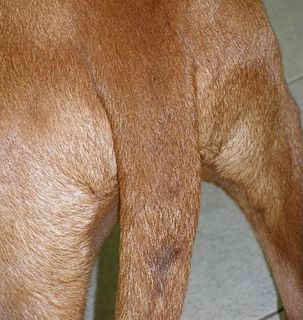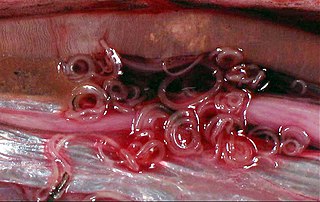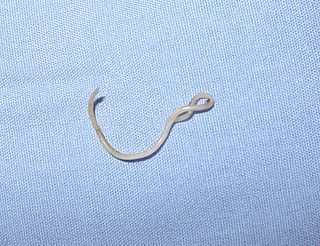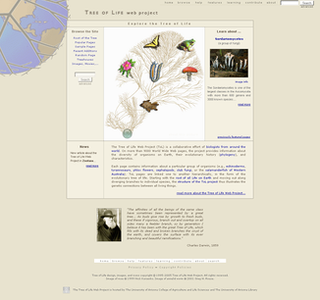The excretory system is a passive biological system that removes excess, unnecessary materials from the body fluids of an organism, so as to help maintain internal chemical homeostasis and prevent damage to the body. The dual function of excretory systems is the elimination of the waste products of metabolism and to drain the body of used up and broken down components in a liquid and gaseous state. In humans and other amniotes most of these substances leave the body as urine and to some degree exhalation, mammals also expel them through sweating.

The bulbourethral gland or Cowper's gland is one of two small exocrine glands in the reproductive system of many male mammals. They are homologous to Bartholin's glands in females. The bulbouretheral glands are responsible for producing pre-ejaculate, a fluid secreted during sexual arousal neutralizing the acidity of the urethra in preparation for the passage of sperm cells.

Musk deer can refer to any one, or all seven, of the species that make up Moschus, the only extant genus of the family Moschidae. The musk deer family differs from cervids, or true deer, by lacking antlers and facial glands and by possessing only a single pair of teats, a gallbladder, a caudal gland, a pair of tusk-like teeth and—of particular economic importance to humans—a musk gland.

Trematoda is a clade within the phylum Platyhelminthes. It includes two groups of parasitic flatworms, known as flukes.

The seminal vesicles, vesicular glands, or seminal glands, are a pair of simple tubular glands posteroinferior to the urinary bladder of some male mammals. Seminal vesicles are located within the pelvis. They secrete fluid that partly composes the semen.

The vas deferens, also called ductus deferens, is part of the male reproductive system of many vertebrates; these ducts transport sperm from the epididymis to the ejaculatory ducts in anticipation of ejaculation. It is a partially coiled tube which exits the abdominal cavity through the inguinal canal.

The ejaculatory ducts are paired structures in male anatomy. Each ejaculatory duct is formed by the union of the vas deferens with the duct of the seminal vesicle. They pass through the prostate, and open into the urethra at the seminal colliculus. During ejaculation, semen passes through the prostate gland, enters the urethra and exits the body via the urinary meatus.
The nephridium is an invertebrate organ which occurs in pairs and performs a function similar to the vertebrate kidney. Nephridia remove metabolic wastes from an animal's body. They are present in many different invertebrate lines. There are two basic types, metanephridia and protonephridia, but there are other types.
Secernentea was a class of nematodes in the Classical Phylogeny System and is no longer in use. This morphological-based classification system has been replaced by the Modern Phylogeny system, where taxonomy assignment is based on small subunit ribosomal DNA.

The violet gland or supracaudal gland is a gland located on the upper surface of the tail of certain mammals, including European badgers and canids such as foxes, wolves, and the domestic dog, as well as the domestic cat. Like many other mammalian secretion glands, the violet gland consists of modified sweat glands and sebaceous glands.

The mammary ridge or mammary crest, is a primordium specific for the development of the mammary gland.

The mesonephros is one of three excretory organs that develop in vertebrates. It serves as the main excretory organ of aquatic vertebrates and as a temporary kidney in reptiles, birds, and mammals. The mesonephros is included in the Wolffian body after Caspar Friedrich Wolff who described it in 1759.

Paracanthurus hepatus is a species of Indo-Pacific surgeonfish. A popular fish in marine aquaria, it is the only member of the genus Paracanthurus. A number of common names are attributed to the species, including regal tang, palette surgeonfish, blue tang, royal blue tang, hippo tang, blue hippo tang, flagtail surgeonfish, Pacific regal blue tang, and blue surgeonfish.

The Chromadorea are a class of the roundworm phylum, Nematoda. They contain a single subclass (Chromadoria) and several orders. With such a redundant arrangement, the Chromadoria are liable to be split up if the orders are found to form several clades, or abandoned if they are found to constitute a single radiation.
Glandulocaudinae is a subfamily of tropical characin fish from Central and South America. In all species of this subfamily, a gland on their caudal fin is found almost exclusively in the males, which allows the release and pumping of pheromones; also, members of this subfamily have complex courtship behaviors which lead to insemination. The ecology and life history of these fish is complex yet little studied. Glandulocaudines are important as food fish for larger fish important for commercial and subsistence reasons.

Toxocara canis is a worldwide-distributed helminth parasite of dogs and other canids. The name is derived from the Greek word "toxon," meaning bow or quiver, and the Latin word "caro," meaning flesh. They live in the small intestine of the definitive host. In adult dogs, the infection is usually asymptomatic but may be characterized by diarrhea. By contrast, massive infection with Toxocara canis can be fatal in puppies, causing diarrhea, vomiting, an enlarged abdomen, flatulence, and poor growth rate.

The excretory system of gastropods removes nitrogenous waste and maintains the internal water balance of these creatures, commonly referred to as snails and slugs. The primary organ of excretion is a nephridium.
Most insects reproduce oviparously, i.e. by laying eggs. The eggs are produced by the female in a pair of ovaries. Sperm, produced by the male in one testis or more commonly two, is transmitted to the female during mating by means of external genitalia. The sperm is stored within the female in one or more spermathecae. At the time of fertilization, the eggs travel along oviducts to be fertilized by the sperm and are then expelled from the body ("laid"), in most cases via an ovipositor.
Eustrongylidosis is a parasitic disease that mainly affects wading birds worldwide; however, the parasite’s complex, indirect life cycle involves other species such as aquatic worms and fish. Moreover, this disease is zoonotic which means the parasite can transmit disease from animals to humans. Eustrongylidosis is named after the causative agent Eustrongylides and typically occurs in eutrophicated waters where concentrations of nutrients and minerals are high enough to provide ideal conditions for the parasite to thrive and persist. Because eutrophication has become a common issue due to agricultural runoff and urban development, cases of Eustrongylidosis are becoming prevalent and hard to control. Eustrongylidosis can be diagnosed before or after death by observing behavior, clinical signs and performing fecal flotations and necropsies. Methods to control Eustrongylidosis include preventing eutrophication and providing hosts with uninfected food sources in aquaculture farms. Parasites are known to be indicators of environmental health and stability and should therefore be studied further to better understand the parasite’s life cycle and how it affects predator-prey interactions and improve conservation efforts.














